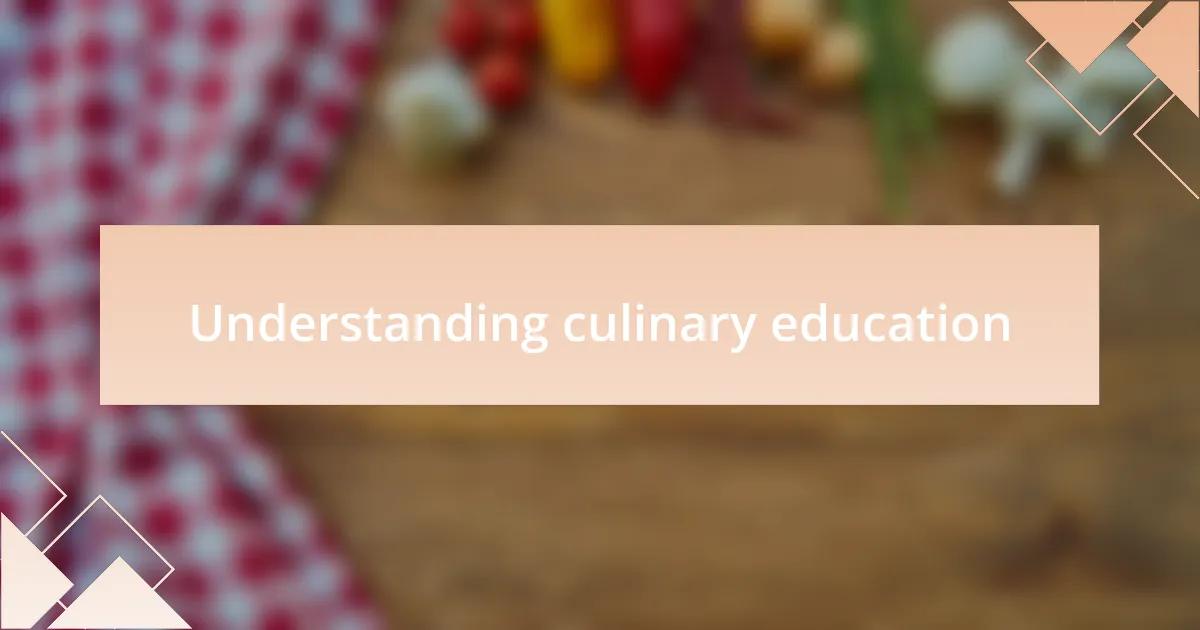Key takeaways:
- Culinary education intertwines personal history and cultural heritage, deepening appreciation for food traditions.
- Exploring ancestral food traditions enhances a sense of belonging and preserves family narratives.
- Researching family recipes is a heartfelt journey that honors past generations while creating legacies for future ones.
- Sharing meals fosters connections among family members, transforming dining into rich storytelling experiences.

Understanding culinary education
Culinary education is more than just learning to chop vegetables or follow a recipe; it’s about understanding the cultural stories behind the foods we prepare. I remember my first cooking class, where the instructor shared her family’s traditional dish, igniting a passion in me to explore my own roots. Isn’t it fascinating how food connects us to our heritage and personal history?
As students dive deeper into culinary education, they uncover the science of flavor and the artistry of presentation, combining creativity with technique. This blend can sometimes feel overwhelming, but I find that each failed dish teaches a valuable lesson. Think of a time you tried to recreate a family recipe and it didn’t turn out quite right—did that stop you, or did it inspire you to try again?
The joy of culinary education lies in its evolution; every dish carries a memory and a lesson. I often think about the meals shared around my grandmother’s table, which were much more than food—they were gatherings filled with laughter and love. How fulfilling is it to reclaim those experiences through the lens of education and cooking?

The importance of cultural heritage
Cultural heritage shapes our relationships with food, bringing meaning to every meal we create. I remember the first time I made my family’s traditional stew; the aroma brought back memories of my mother’s kitchen filled with love and warmth. Have you ever cooked a dish that transported you back to cherished moments in your life?
Understanding the stories behind our ancestors’ foods deepens our appreciation for culinary traditions. I often think about how my great-grandmother would spend hours preparing meals that were not just sustenance but also a way to preserve our family identity. Doesn’t it make you realize that food is a powerful narrative that connects us across generations?
Preserving cultural heritage through food is about honoring those who came before us. When I explore my roots, I’m not just cooking; I’m keeping alive the flavors and customs that define my identity. Isn’t it invigorating to think that each bite holds a piece of our history?

Exploring ancestral food traditions
Exploring ancestral food traditions is like opening a cherished book filled with family stories. I vividly recall watching my grandmother grind spices in her small kitchen, her hands moving deftly while she shared tales from her childhood. How fascinating it is that just a handful of ingredients can encapsulate generations of wisdom and experience!
As I delve deeper into my family’s culinary heritage, I find myself recreating dishes that evoke a sense of belonging. The first time I savored a recipe passed down from my great-uncle, I felt a surge of connection to my lineage, almost as if his spirit was guiding my hands. Have you ever experienced that moment where a recipe suddenly becomes a bridge to your ancestors?
When I participate in communal cooking events, it’s a beautiful reminder of how food traditions bind us together. Each cooking session becomes a lesson in history, where I learn not just the techniques, but also the emotions woven into each dish. Isn’t it remarkable how sharing a meal can transform us into storytellers, keeping our ancestry vibrant and alive?

Researching family recipes
The journey of researching family recipes often begins with cherished conversations. I remember sitting around the dining table, notebook in hand, as my aunt recounted her attempts to recreate my grandmother’s famous stews. “It’s not just about the ingredients,” she insisted, “it’s about the love and memories infused in every batch.” This inspired me to reach out to different family members, eager to gather their stories and recipes.
After uncovering a few hidden gems, I experienced a joyful challenge in piecing them together. One recipe for my great-grandmother’s hand-rolled dumplings was especially elusive. While preparing to make them myself, I found myself experimenting with techniques shared by various family members, merging their insights until I could almost hear my great-grandmother’s laughter guiding me in the kitchen. Doesn’t it feel incredible when you can taste not just the food, but the love and history embedded in every bite?
As I sifted through old recipe cards and faded notes, I stumbled upon handwritten letters detailing the struggles and triumphs of my ancestors in the kitchen. Each recipe told a story, reflecting their unique circumstances and eras. It’s moments like these that truly tug at the heartstrings—realizing that cooking is a way to honor those who came before us, while simultaneously creating a legacy for the generations to follow. Have you ever felt that lingering connection when preparing a family dish?

Techniques for recreating traditional dishes
When it comes to recreating traditional dishes, technique plays a crucial role. I recall the first time I attempted my grandmother’s celebrated pie crust. Instead of rushing through, I took a deep breath and focused on the method: chilling the butter, handling the dough with care, and letting it rest. This mindfulness made the process more rewarding and closer to what she would have done.
One technique that has remained a game-changer for me is the art of layering flavors. For instance, when making my great-uncle’s robust chili, I learned to sauté the onions and garlic before adding the spices—a step I initially overlooked. It was fascinating to realize how these small adjustments could deepen the dish’s complexity. Have you ever noticed how one little tweak can transform the entire taste?
Moreover, I’ve found that practicing patience is equally important. I once dedicated an afternoon to simmering a rich broth, a staple in my family’s cuisine. Waiting for the aromatic flavors to meld taught me that some dishes require time and love to reach their full potential. In our fast-paced world, it’s easy to forget that great cooking often honors the old ways—slow, steady, and filled with intention. How do you approach cooking with patience?

Sharing meals with family
Sharing meals with family creates a sense of connection and reinforces traditions that often define who we are. I vividly remember crowded evenings at my parents’ dining table, where laughter and lively discussions flowed as freely as our homemade pasta. It’s amazing how a simple dish can spark memories and foster bonds, isn’t it?
One of my most cherished family traditions involves Sunday dinners, where each member brings a dish inspired by their culinary journey. I learned the joy of sharing not just food, but stories behind each recipe. Just last week, my cousin brought her mother’s famous curry, and hearing the anecdotes attached to it deepened our appreciation for the meal. These shared stories transform a mere meal into a delightful tapestry of our family’s history.
Even a casual weeknight dinner can become a memorable occasion when we take the time to appreciate the moment. I often find that when we pause to share what we’re grateful for before eating, it turns an ordinary routine into something special. Have you ever experienced that shift in atmosphere when gratitude fills the air? It’s those little rituals that make the food feel richer and the bonds stronger.

Connecting through food experiences
Food experiences create a unique pathway to connect with our ancestors. I often find myself cooking my grandmother’s recipes, feeling her presence in every stir and seasoning. It’s as though her spirit guides my hand, reminding me of family gatherings where we’d share not just a meal, but the essence of our heritage. Isn’t it fascinating how food can bridge generations in such a visceral way?
One particular dish that speaks volumes is her roasted beet salad, a vibrant mix of earthy flavors and textures. Preparing it has become a ritual for me; I recall her diligent efforts in the kitchen, carefully selecting fresh ingredients at the market. Each time I share that salad with friends, I’m not just serving food but sharing a piece of my lineage, sparking conversations about ancestry and the richness of our familial roots. Can food truly carry history in its taste? I believe it can, and every bite whispers stories of those who came before us.
Reflecting on food experiences can illuminate the diverse narratives within our culture. I remember the first time I made tamales during a family gathering, guided by the hands of my aunts. The process required patience and teamwork, bonding us as we laughed and learned together. This experience wouldn’t have just been about creating tamales; it was about preserving a culinary legacy while reinforcing our familial ties. Don’t you think such moments underscore the importance of food as a conduit for connection?